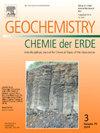Coupling hydrolyzed rice husk and ferric oxidation to enhance bio-oxidation of gold concentrate with high arsenic and sulfur
IF 2.9
3区 地球科学
Q2 GEOCHEMISTRY & GEOPHYSICS
引用次数: 0
Abstract
The bio-oxidation efficiency of refractory gold concentrate with high arsenic and sulfur is generally limited. In present study, the two-step ferric-biological process was employed to treat this gold concentrate, with an emphasis on investigating the impact of different organic nutrients on bio-oxidation performance. The results indicated that the addition of appropriate dosage of hydrolyzed rice husk (HRH, 1.2 g/L) combined with ferric oxidation significantly improved the bio-oxidation efficiency. The microbial growth rate and adsorption capacity were increase by 1.75 and 1 times, respectively. Specifically, it effectively facilitated the growth and adsorption of Sulfobacillus spp., while exhibiting no significant inhibitory effect on Leptospirillum spp. growth. Consequently, the homogeneity of the planktonic microbial community was improved. These effects resulted in a 0.06, 0.84, and 1.03 times increase in the oxidation efficiency of As, Fe, and S compared with one-step bio-oxidation, achieving extraction levels of 98.4 ± 0.2 %, 74.5 ± 0.1 %, and 60.4 ± 1.0 %, respectively. In consequence, the extraction levels of Au and Ag increased by 63.0 % and 51.3 %, respectively, reaching 93.7 ± 0.6 % and 91.6 ± 0.5 %. This study elucidated the enhancement mechanism of HRH on bio-oxidation and provided a theoretical basis for the efficient utilization of refractory gold ores and the application of lignocellulose in biohydrometallurgy.
稻壳水解与铁氧化耦合促进高砷高硫金精矿生物氧化
高砷高硫难处理金精矿的生物氧化效率普遍有限。采用铁-生物两步法处理该金精矿,重点研究了不同有机营养物对其生物氧化性能的影响。结果表明,添加适量的水解稻壳(HRH, 1.2 g/L),配合铁氧化,显著提高了生物氧化效率。微生物生长速率和吸附量分别提高1.75倍和1倍。具体来说,它能有效促进亚硫酸盐杆菌的生长和吸附,而对钩端螺旋体的生长没有明显的抑制作用。从而提高了浮游微生物群落的均匀性。结果表明,与一步法氧化相比,砷、铁和硫的氧化效率分别提高了0.06倍、0.84倍和1.03倍,萃取率分别为98.4%±0.2%、74.5±0.1%和60.4±1.0%。Au和Ag的提取率分别提高了63.0%和51.3%,分别达到93.7±0.6%和91.6±0.5%。本研究阐明了HRH对生物氧化的增强机理,为难处理金矿的高效利用和木质纤维素在生物湿法冶金中的应用提供了理论依据。
本文章由计算机程序翻译,如有差异,请以英文原文为准。
求助全文
约1分钟内获得全文
求助全文
来源期刊

Chemie Der Erde-Geochemistry
地学-地球化学与地球物理
CiteScore
7.10
自引率
0.00%
发文量
40
审稿时长
3.0 months
期刊介绍:
GEOCHEMISTRY was founded as Chemie der Erde 1914 in Jena, and, hence, is one of the oldest journals for geochemistry-related topics.
GEOCHEMISTRY (formerly Chemie der Erde / Geochemistry) publishes original research papers, short communications, reviews of selected topics, and high-class invited review articles addressed at broad geosciences audience. Publications dealing with interdisciplinary questions are particularly welcome. Young scientists are especially encouraged to submit their work. Contributions will be published exclusively in English. The journal, through very personalized consultation and its worldwide distribution, offers entry into the world of international scientific communication, and promotes interdisciplinary discussion on chemical problems in a broad spectrum of geosciences.
The following topics are covered by the expertise of the members of the editorial board (see below):
-cosmochemistry, meteoritics-
igneous, metamorphic, and sedimentary petrology-
volcanology-
low & high temperature geochemistry-
experimental - theoretical - field related studies-
mineralogy - crystallography-
environmental geosciences-
archaeometry
 求助内容:
求助内容: 应助结果提醒方式:
应助结果提醒方式:


